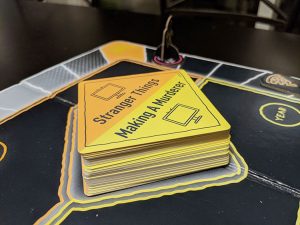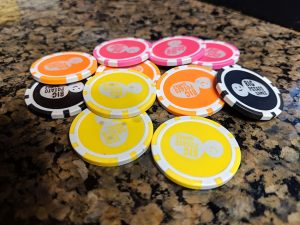Upon returning home from work, I’m greeted to a box, which posed the question: what came first, the U.S. Postal System or the U.S. Stamp? Well, I don’t know! Do you? Don’t cheat. Just answer the poll impulsively.
What Came First? is a 2-8 player party betting game from Big Potato Games. It’s for ages 10+ and plays in about 20 minutes.
Gameplay Overview:
What Came First? has teams placing bets in a race to the finish line. Setup for the game is easy. Divide into teams as evenly as possible and take all the chips of one color. Next, each team will select a secret time token and place it face down on an open movement space. These time tokens will give whoever lands on it a benefit or hindrance.
On a turn, teams will place their chips on one of two sides at the center of the board, betting on what they think came first. If correct, teams move their tokens forward the number of spaces as was bet. If it was incorrect, they move back that many spaces. Also, players will also be able to place a bet on the year they believe the thing came first. If they guess correctly, they will move 5 additional spaces. But teams will have to have bet on the correct choice to get this benefit. For example, if a team bet two on their chips on Pepsi coming before Coke and also bet and guessed correctly the year being 1965, they would move a total of 7. By the way, that information is wrong and I didn’t just spoil it for you. I’m not a monster.

Game Experience:
This is a light party game so there shouldn’t be any expectations for strategy or complexity. This is a game that can be played in a casual, social setting where people might want to play a game but also still talk to one another. I know that sounds like heresy to the hobby board gamer, but this game affords that opportunity when playing with family or other casual settings. I plan to get this game out during holidays to play with family members who don’t play a lot of games. It’s accessible and I don’t foresee them needing to ask a lot of questions during the game. The only thing I typically had to reference during my plays was what each time token meant, as these just have unintuitive pictures that don’t indicate what their actions are.

This game isn’t a large time commitment. Because everyone mostly takes their turns together, we got through games in about the time as advertised. Early bad bets can mean you are definitely behind the eight ball in progressing. I had a friend who never crossed the start line because they made so many bad bets and I made so many good bets, that the game was over before they even had a chance. You might have games that end this way. But the fact that the games don’t last very long makes this a non-issue.
I think you can get a lot of games out of What Came First?. There are quite a large number of choice cards included in the game and you probably won’t use a whole lot of them each game. This will depend on how quickly somebody moves around the board to the finish line, but I could see this game getting enough plays before the need to shuffle choice cards would need to happen.

The components for the game are fairly basic, but on par for the price. The betting chips are weighted and have a nice, casino-like feel to them. You might find yourself moving them around in your hand while deciding your bet. I will say, the pieces you’ll use to move around the board are not good. They are meant to be held up with cardboard in a grooved spot, but all they manage to do is fall out when you lift the piece to move it. This could’ve been fixed using a plastic standee. Our solution was just to remove this bottom piece and lay the pieces down as they moved around.
Final Thoughts:
What Came First? is a party game that does what it’s supposed to: be easy to teach and set up, last under 30 minutes, and provide some social interaction for players. This game is not going to be at the top of everyone’s list, especially if you tend to steer away from these types of games. This isn’t an evergreen title and eventually, it will leave the collection. But that’s not to say that there aren’t groups and players who would find an enjoyable gaming experience.
Also, take the survey. All the cool kids are.
Final Score: 3.5 Stars – a game worth its cost and does what it’s supposed to by providing a good time
Hits:
• Provides enjoyable play for social/light game settings
• Easy to get to the table and taught
• Good value for the number of plays it’s likely to see
Misses:
• Player token bases are frustrating and useless























